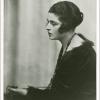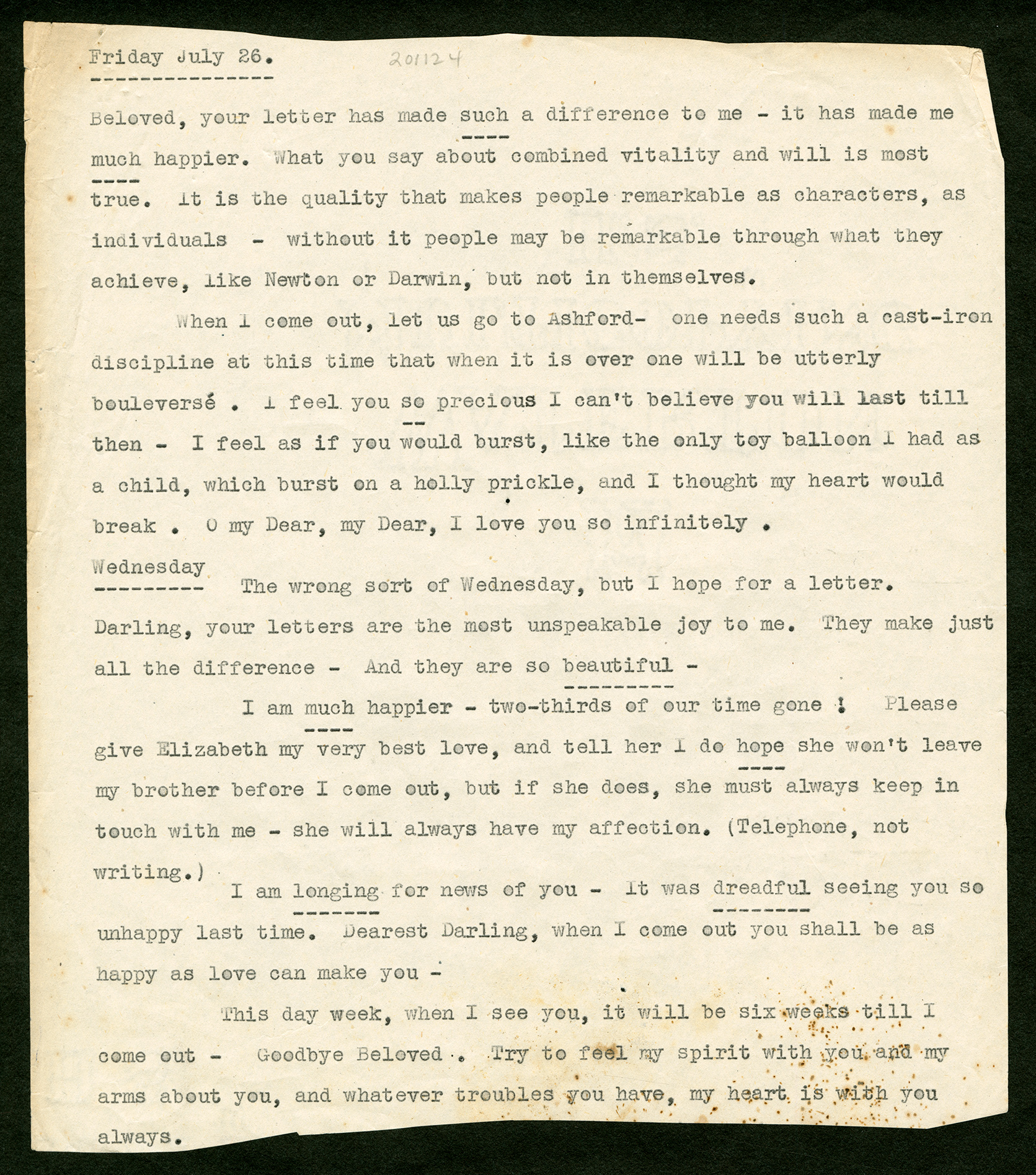
Brixton Letter 55
BR to Constance Malleson
July 31, 1918
- TL(TC)
- McMaster
- Edited by
Kenneth Blackwell
Andrew G. Bone
Nicholas Griffin
Sheila Turcon
Cite The Collected Letters of Bertrand Russell, https://russell-letters.mcmaster.ca/brixton-letter-55
BRACERS 116363
<Brixton Prison>1
Wednesday2
The wrong sort of Wednesday,3 but I hope for a letter. Darling, your letters4 are the most unspeakable joy to me. They make just all the difference. And they are so beautiful.
I am much happier — two-thirds of our time5 gone! Please give Elizabeth my very best love, and tell her I do hope she won’t leave my brother before I come out, but if she does, she must always keep in touch with me — she will always have my affection. (Telephone, not writing.)
I am longing for news of you — it was dreadful seeing you so unhappy last time.6 Dearest Darling, when I come out you shall be as happy as love can make you.
This day week, when I see you, it will be six weeks till I come out.7 Goodbye Beloved. Try to feel my spirit with you and my arms about you, and whatever trouble you have, my heart is with you always.
- 1
[document] The letter was extracted from that part beginning “Wednesday” of a typescript, document 201124 in the Malleson papers in the Russell Archives. This document is a typed transcription made by Colette at an unknown date. A manuscript version of this text could not be found. The earlier part of the typescript constitutes Letter 49. There is a second typing of the two texts at RA1 710.052423.
- 2
[date] Since this letter, dated simply “Wednesday”, was typed below the transcription of another letter, which was dated “Friday 26th” on the same sheet, it is assumed that the current letter should be dated Wednesday, 31 July.
- 3
wrong sort of Wednesday That is, a Wednesday when Colette was not going to visit him in prison.
- 4
your letters Colette was a regular sender of letters once the smuggling plan went into effect. Before that she sent messages via The Times and in the “official” letters.
- 5
two-thirds of our time BR meant that two-thirds of his sentence had been served, on the assumption of an early release date of about 2 October.
- 6
seeing you so unhappy last time In Letter 47 BR had also mentioned Colette’s sadness during her prison visit of 23 July.
- 7
six weeks till I come out This projects a release time of mid-September 1918. BR was confident that his brother, Frank, would be able to secure this earlier than expected release. See note 3 on “Sep. 18” in Letter 52.
Brixton Prison
Located in southwest London Brixton is the capital’s oldest prison. It opened in 1820 as the Surrey House of Correction for minor offenders of both sexes, but became a women-only convict prison in the 1850s. Brixton was a military prison from 1882 until 1898, after which it served as a “local” prison for male offenders sentenced to two years or less, and as London’s main remand centre for those in custody awaiting trial. The prison could hold up to 800 inmates. Originally under local authority jurisdiction, local prisons were transferred to Home Office control in 1878 in an attempt to establish uniform conditions of confinement. These facilities were distinct from “convict” prisons reserved for more serious or repeat offenders sentenced to longer terms of penal servitude.
Elizabeth Russell
Elizabeth Russell, born Mary Annette Beauchamp (1866–1941), was a novelist who in 1891 married Graf von Arnim-Schlagenthin. She became known as “Elizabeth”, the name she used in publishing Elizabeth and Her German Garden (1898), and she remained widely known as Elizabeth von Arnim, although the Library of Congress catalogues her as Mary Annette (Beauchamp), Countess von Arnim. She was a widow when she married BR’s brother, Frank, on 11 February 1916. The marriage was quickly in difficulty; she left it for good in March 1919, but they were never divorced and she remained Countess Russell (becoming Dowager Countess after Frank’s death in 1931).
Frank Russell
John Francis (“Frank”) Stanley Russell (1865–1931; 2nd Earl Russell from 1878), BR’s older brother. Author of Lay Sermons (1902), Divorce (1912), and My Life and Adventures (1923). BR remembered Frank bullying him as a child and as having the character and appearance of a Stanley, but also as giving him his first geometry lessons (Auto. 1: 26, 36). He was accomplished in many fields: sailor, electrician, house builder, pioneer motorist, local politician, lawyer, businessman and company director, and (later) constructive junior member of the second Labour Government. Frank was married three times. The first marriage involved serious legal actions by and against his wife and her mother, but a previous scandal, which ended his career at Oxford, had an overshadowing effect on his life (see Ruth Derham, “‘A Very Improper Friend’: the Influence of Jowett and Oxford on Frank Russell”, Russell 37 [2017]: 271–87). The second marriage was to Mollie Sommerville (see Ian Watson, “Mollie, Countess Russell”, Russell 23 [2003]: 65–8). The third was to Elizabeth, Countess von Arnim. Despite difficulties with him, BR declared from prison: “No prisoner can ever have had such a helpful brother” (Letter 20).
Constance Malleson
Lady Constance Malleson (1895–1975), actress and author, was the daughter of Hugh Annesley, 5th Earl Annesley, and his second wife, Priscilla. “Colette” (as she was known to BR) was raised at the family home, Castlewellan Castle, County Down, Northern Ireland. Becoming an actress was an unusual path for a woman of her class. She studied at Tree’s (later the Royal Academy of Dramatic Art), debuting in 1914 with the stage name of Colette O’Niel at the Duke of York’s Theatre, London, in a student production. She married fellow actor Miles Malleson (1888–1969) in 1915 because her family would not allow them to live together. In 1916 Colette met BR through the No-Conscription Fellowship and began a love affair with him that lasted until 1920. The affair was rekindled twice, in 1929 and 1948; they remained friends for the rest of his life. She had a great talent for making and keeping friends. Colette acted in London and the provinces. She toured South Africa in 1928–29 and the Middle East, Greece and Italy in 1932 in Lewis Casson and Sybil Thorndike’s company. She acted in two films, both in 1918, Hindle Wakes and The Admirable Crichton, each now lost. With BR’s encouragement she began a writing career, publishing a short story in The English Review in 1919. She published other short stories as well as hundreds of articles and book reviews. Colette wrote two novels — The Coming Back (1933) and Fear in the Heart (1936) — as well as two autobiographies — After Ten Years (1931) and In the North (1946). She was a fierce defender of Finland, where she had lived before the outbreak of World War II. Letters from her appeared in The Times and The Manchester Guardian. Another of her causes was mental health. She died five years after BR in Lavenham, Suffolk, where she spent her final years. See S. Turcon, “A Bibliography of Constance Malleson”, Russell 32 (2012): 175–90.
